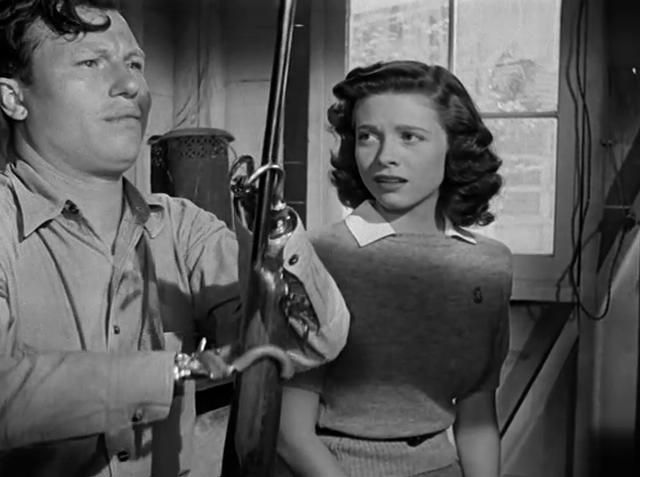The winner of this year’s Oscar Award for Best Picture, Nomadland, drew a lot of attention for its use of nonprofessional actors in key roles. Characters like Linda May, Bob Wells, and the indelible Swankie are regular folks who portray lightly fictionalized versions of themselves in the movie, and their sheer authenticity deepen the film’s emotional resonance. Audiences relate to the cinematic world of Nomadland because it feels true to life—and the true-to-life people on screen help make it so.

in The Best Years of Our Lives
A similarly gutsy casting decision helped produce a Best Picture Oscar 74 years ago for a film that’s widely regarded as one of the best ever. The Best Years of Our Lives follows three servicemen as they struggle to rejoin civilian life after their experiences in World War II. They battle addiction, depression, flashbacks, and more, while wondering why victory in combat feels so much like defeat back home. The film’s honest depiction of a triumphant but unsettled postwar nation struck a chord. Best Years of Our Lives won a then-record eight Oscars and swept nearly all the major categories, including Best Picture, Best Director (William Wyler), Best Screenplay (Robert Stephenson), and Best Actor (Frederic March).
But its most unlikely piece of hardware went to Harold Russell for Best Supporting Actor.
A 31-year-old Army veteran who’d never acted before, Russell was cast as Homer Parrish, a naval officer who comes home from the war after losing both arms below the elbow. The character reflects Russell’s personal experiences: Two years before production began, he lost his upper limbs when a faulty munition detonated in his hands during a training exercise. Wyler offered him the role after seeing Russell in a 1945 Army short about disabled war veterans called Diary of a Sergeant. He even modified the script to give the fictional Parrish more of the actor’s natural temperament and demeanor. Even so, Russell took the part with great reluctance, out of fear that he’d come off looking like a foolish amateur.
The Motion Picture Academy thought otherwise, honoring him with a nomination in an exceptionally competitive field. Russell made the Oscar shortlist that year over past and future nominees such as Lionel Barrymore (Mr. Potter in It’s a Wonderful Life), Gregory Peck (Lewt McCanles in Duel in the Sun), and Hume Cronyn and Cecil Kellaway (Nick and Arthur, respectively, in The Postman Always Rings Twice). His co-nominees were equally formidable; the finalists included Claude Rains (nominated for the fourth time in 1946) and Charles Coburn (also up for the fourth time).
Academy honchos didn’t think Russell had any shot at winning, but they wanted to recognize his unique performance with a feel-good moment. So, prior to the presentation of the major awards, they called him to the stage and gave him an honorary Oscar “for bringing hope and courage to his fellow veterans through his appearance in The Best Years of Our Lives.” Russell accepted the statuette “in the name of all those thousands of disabled veterans who are laying in hospitals all over the country.” Later on, when presenter Anne Revere opened the envelope for Best Supporting Actor and read Russell’s name, he was as startled as anyone. In one of the shortest acceptance speeches ever, he simply blurted: “Two in a night is too much! Thanks a lot.”
He thereby become the only actor in history to win two Oscars for a single performance. Never happened before or since.
William Wyler says Russell delivered “the finest performance I have ever seen on the screen.” That’s pretty high praise from a man who directed Laurence Olivier, Bette Davis, Greer Garson, Olivia de Havilland, Audrey Hepburn, and Charlton Heston in Oscar-nominated roles. We wish we could say Russell went on to a long and fruitful screen career, but roles for disabled actors weren’t any more common then than they are now. And, to be fair, Russell was no more enthusiastic about acting after his Oscar victory than he had been before it. Had any roles been offered, he might not have been interested. Remaining true to his natural character, he served in leadership roles for American Veterans and the World Veterans Fund. He later spent nearly 30 years and six administrations as chairman of the President’s Commission on Employment of the Handicapped.
Russell did eventually return to the screen in the 1980s for a couple of film roles and two television appearances. In 1992 he auctioned off his Best Supporting Actor trophy, raising about $60,000 to pay for his wife’s medical bills (he said at the time) or for a luxury cruise (it was later claimed).
Summing up his outlook in his autobiography, Russell wrote: “It is not what you have lost but what you have left that counts.” You can find Best Years of Our Lives on Vudu, YouTube, iTunes, Amazon Prime, and elsewhere.
Related articles:
The Sexiest Amputee Movie You’ve Never Seen
Locke and Key’s Eric Graise Steps Up and Speaks Out
Sundance Film Festival Movies About Amputees
Six-Pack of Short Movies By and About Amputees
Amputee Caregivers Shine in “Sky Blossoms”